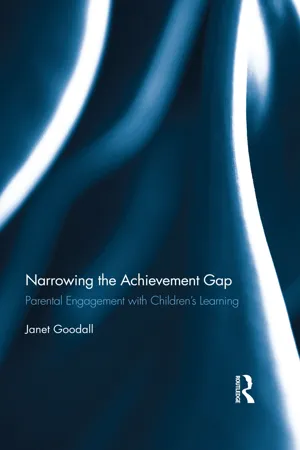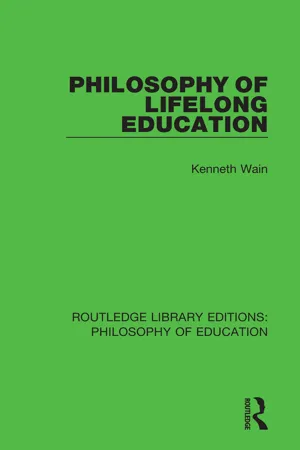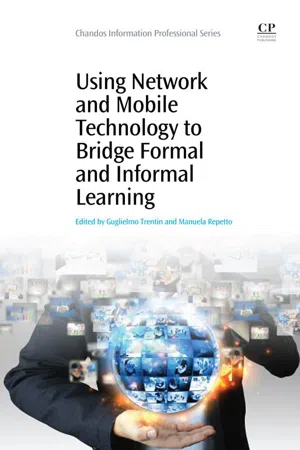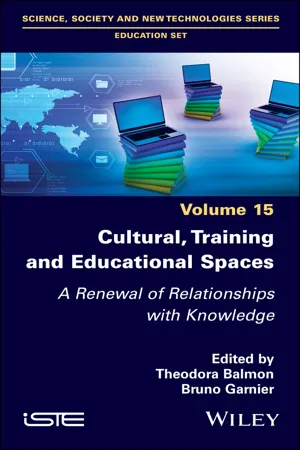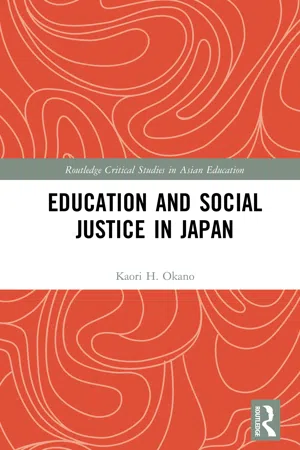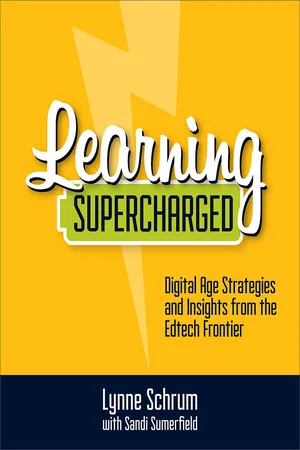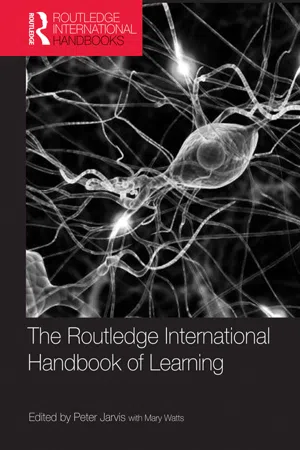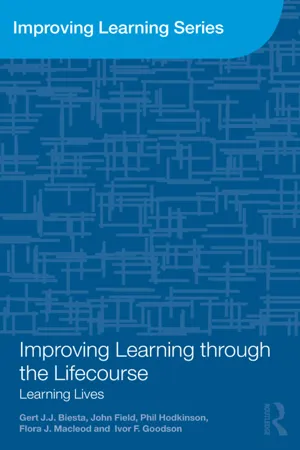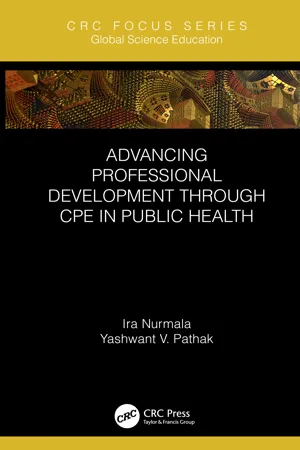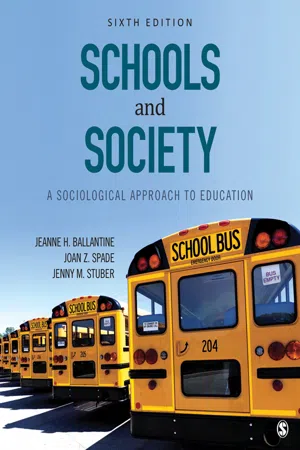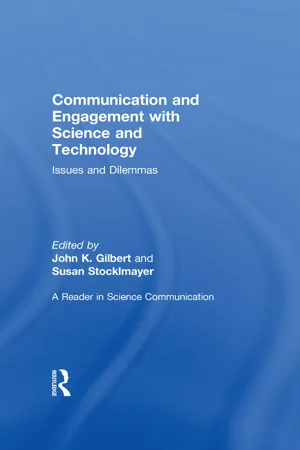Social Sciences
Formal and Informal Education
Formal education refers to structured, institutionalized learning provided in schools and universities, leading to recognized qualifications. Informal education, on the other hand, occurs outside of traditional educational settings and is often experiential and spontaneous, such as learning from family, community, or personal experiences. Both forms of education play crucial roles in shaping individuals' knowledge, skills, and values.
Written by Perlego with AI-assistance
Related key terms
Related key terms
1 of 4
Related key terms
1 of 3
12 Key excerpts on "Formal and Informal Education"
- eBook - ePub
Narrowing the Achievement Gap
Parental Engagement with Children's Learning
- Janet Goodall(Author)
- 2017(Publication Date)
- Routledge(Publisher)
Sidorkin (2011) points out the possible conflict here in that societies which style themselves as democratic may be anything but in relation to children and schooling. Most industrialised countries compel children by law to be involved in schooling of some kind, without reference to the wishes of the child in question. However, this still does not constitute indoctrination as there is no attempt to instil knowledge or belief by force or overriding of the agency of the learner – children are not compelled by law to learn but rather to attend (school). This leads to a final adaptation of Peters’s criteria such that education is a process carried out in a worthwhile manner which respects the agency of the learner and which concerns something more than mere technical skill. This then leads us to examine a differentiation between Formal and Informal Education. Formal and Informal Education Simply put, formal education (as a subset of education as a whole) takes place in formalised institutions, and informal education does not (Brookfield 1986, Cox et al. 2000, Rogers 2000, Tuijnman and Bostrõm 2002). These formal institutions take in the obvious candidates, such as schools, colleges and universities. Arguably, however, education is ‘formal’ whenever it follows particular, set formula or is delivered under the aegis of any group which sees itself as broadly educative. In this way, one might speak of formal education taking place within groups such as the Girl Guides and the Boy Scouts, with their stepped system of learning leading to awards (badges); the St John’s ambulance society, which instructs volunteers in various methods of first aid; and even the Masons, with lore and ritual to be learned by initiates - eBook - ePub
- Kenneth Wain(Author)
- 2016(Publication Date)
- Routledge(Publisher)
By informal education is meant that planned or deliberate instruction a tutor may provide, or a parent may give a child, or a master impart to an apprentice. But more than that it includes the self education a person may seek through a planned course of reading in the library, or secure through conversation with friends, or obtain by travel or general observation or by use of one or more of several mass media now so freely at hand. Thus informal education may be planned or deliberately imposed on another, or it may result from selfmotivation and be self imposed. Sometimes it may result more from chance than from design. What distinguishes it from schooling is that there is no institution especially provided in which it takes place, although informal education may occur in school even during regular class time.[28 ]But, clearly, within this ponderous description, which scarcely allows any space for formal learning even, there is scope for sub-divisions that can be made coherently and effortlessly. Indeed the very ponderousness of the class of the informal as defined by Park cries for sub-division, and this is effected in a clear-cut and economic way by Chazan who furnishes the following technical definitions of each term that have the advantage also, in our case, of reflecting, more or less, the distinctions worked with within the lifelong education literature:Formal education: the hierarchically structured, chronologically graded 'education system', running from primary schools through the university and including, in addition to general academic studies, a variety of specialised programmes and institutions for full-time technical and professional training.Informal education: the truly lifelong process whereby every individual acquires attitudes, values, skills and knowledge from daily experience and the educative influences and resources in his or her environment - from family and neighbours, from work and play, from the market place, the library and the mass media.Non-formal education: any organisational activity outside the established formal system whether operating separately or as an important feature of some broader activity - that is intended to serve identifiable learning clienteles and learning objectives.[29 ]One final remark about the relationship of informal learning defined as in Chazan (a definition which will continue to be upheld throughout the book) and the lifelong education programme. The link between the programme and the idea of a 'learning society' is, as Cross-Durant claims, a conceptual one because - Guglielmo Trentin, Manuela Repetto(Authors)
- 2013(Publication Date)
- Chandos Publishing(Publisher)
Formal learning has different meanings depending on the context. For example, formal learning relates to the dominant education systems in any country (Hodkinson et al., 2003) and is governed by rules relating to its creation, operation and governance. It can be considered a form of high culture in that not all society members necessarily have access to it. Formal learning can also mean the site of structured learning under the auspices of an educational body which is premised on a set curriculum, a well-defined learning event, and the dedication of time towards the learning experience (Stone, 2009). Formal learning is often associated with didactic, teacher-centric pedagogies and approaches designed to efficiently distribute, or ‘push’ (Hagel, 2005), the necessary and desirable resources or learning materials to the consumer (student). Stuckey and Arkell (2005) refer to these as ‘institutionally-driven’ approaches. Richardson (2006) suggests that in ‘push’ educational models, students are often considered as passive receivers of information. Grinnell (2009) concurs, arguing that this ‘push’ model of instructional delivery is ‘similar to the prevailing information-transfer paradigm where teachers transfer “knowledge” to often passive, unengaged students’. Moreover, as Arif et al. (2005) argue, ‘push’ pedagogical models tend to promote ‘one-size-fits all’ approaches to teaching and learning which is often aligned with instructivist pedagogy. Informal learning opportunities, on the other hand, are emergent, student-driven practices which rely on shared norms rather than rules. Facer (2004: 1) defines informal learning as ‘the sort of learning that goes on as part of our normal day-to-day activities when we don’t even think we are learning’. Siemens (2004) argues that informal learning is simultaneously the most dynamic and versatile, but least recognised, form of learning- eBook - ePub
- John Ambenge(Author)
- 2021(Publication Date)
- Page Publishing, Inc.(Publisher)
As a social institution, education provides members with knowledge, skills, cultural norms, ideologies, and as well as values. It prepares young people for adult roles and adults for new roles and transmits society’s culture to the next generation. Sociologists make a distinction between informal and formal education. Informal education occurs in a spontaneous, unplanned way. Experiences that educate informally occur naturally; someone to stimulate specific thoughts or to impart specific skills does not design them. Formal education is a purposeful, planned effort to impart specific skills or information. It is a systematic process in which someone designs the educating experiences. Education is considered a success when those being instructed acquire the skills, thoughts, and information that those designing the experience seek to impart. Merton proposed that social institutions such as education have functions that are both manifest and latent.Schoolchildren in Kenya take their Kenya Certificate of Primary Education (KCPE).All known societies have some type of educational institutions of sort, either formal or informal but nevertheless function as a social structure for the purpose of accomplishing certain consequences. In the United States, as in other industrialized nations, the education system is large and highly formalized. But in less-industrialized societies, education may consist of parents teaching their children how to fish or till the land and gather food. Under these circumstances, the family or the community is both the educational institution and the kinship institution. Why do societies have educational institutions? How do these institutions benefit society? “The purpose of education is to educate each one of us to think critically and to think intensively. Character plus intelligence—that’s the objective of true education.”The Structural-Functional Analysis Structural-functional PerspectiveThe functionalist theory provides answers to these questions and more. According to the functionalist theory, educational institutions serve important task, or functions, for society. Robert Merton (1949) argued that social structures have different consequences depending on what group is affected and proposed that social institutions such as education in schools have functions that are both manifest and latent. The concepts of dysfunctions and functions along with latent functions and manifest functions were theorized by Merton. - eBook - ePub
Cultural, Training and Educational Spaces
A Renewal of Relationships with Knowledge
- Theodora Balmon, Bruno Garnier(Authors)
- 2023(Publication Date)
- Wiley-ISTE(Publisher)
Carrefours de l’éducation (2018), “L’éducation informelle contre la forme scolaire?” (Informal education versus the school form). This question is particularly interesting, in light of the social hierarchy of knowledge that tends to give major importance to school, considered the preferred – and for some, exclusive – place of learning. In this discriminatory logic, the primacy of the school leads to the minimization of, and even contempt for, everything that can be learned outside the school setting.From this point of view, and to counteract this school-centered perspective, UNESCO has been promoting different forms of knowledge for many years and has invited the multiplication of learning spaces. This institution dedicated to education, culture and science in the service of a better knowledge and recognition of others has produced definitions of “formal”, “informal” and “non-formal” education, in relation to aid programs for developing or emerging countries. These definitions, accompanied by recommendations and proposals for action, have made it possible to become aware of the consistency of informal education and have contributed to its structuring and revaluation. The 2012 report, UNESCO Guidelines on the Recognition, Validation and Accreditation of the Outcomes of Non-formal and Informal Learning, clearly highlights both the need for and the benefits of informal education. Informal education is indeed necessary, because it opens a field of possibilities for young people who would not be in proximity to or in connivance with the school culture. It is a way of extending the range of knowledge without limiting it to school. Informal education also brings a certain benefit, because it recognizes other forms of access to knowledge, and even encourages them.It is therefore necessary to go beyond the sterile opposition that would involve separating Formal and Informal Education, at the risk of producing discrimination and a rejection that would be very harmful for the learners. On the contrary, the objective is to associate these educations by highlighting their complementarity. - eBook - ePub
- Kaori H. Okano(Author)
- 2020(Publication Date)
- Routledge(Publisher)
Here I examine nonformal education for school-aged children, and, in particular, how its relations to formal schooling have changed in the last two decades. 1 Nonformal education is learning that occurs outside formal schools with explicit objectives and a degree of organization to achieve them. Unlike informal education, it is offered by some form of institution (but not formal schools). I conceive nonformal education as a range of educational activities that are located on the continuum between formal education and informal education, in the specific context of contemporary Japan. At one end of the continuum, formal education is intentional, organized learning provided within schools and educational institutions sanctioned by the government (which requires conformity to various standards and guidelines), and is offered systematically with clear objectives and, often, is age-graded. Formal education institutions in Japan are approved by the MEXT as ichijôkô (literally, “article one schools”), on the basis that these schools conform to requirements set out in the School Education Law. These requirements cover such aspects as the curricula, medium of instruction, teachers’ qualifications, minimum levels of facilities, course length, and entry age. Completion of formal education courses provide government-sanctioned qualifications that are recognized as prerequisites for a higher level of education and/or in the labour market. Following this line of logic, I do not include training in the workplace in my remit of formal education. At the other end of the continuum, informal education includes daily experiential learning at work, home, and in the community; or simply experience without clearly articulated learning objectives. Such learning may occur without the learner’s awareness, and there are varying degrees of intentionality in this process - eBook - ePub
Learning Supercharged
Digital Age Strategies and Insights from the EdTech Frontier
- Lynne Schrum, Sandi Sumerfield(Authors)
- 2018(Publication Date)
7Blending of Formal, Nonformal, and Informal Education
I never teach my pupils, I only provide the conditions in which they can learn. —Albert Einstein Learning is not the product of teaching. Learning is the product of the activity of learners. —John HoltIn This Chapter:
• What is known about formal, nonformal, and informal education?• What examples exist on the importance and use of informal and nonformal education?• What ways are formal educational systems and informal entities collaborating?What Is Known About Formal, Nonformal, and Informal Learning?How did you learn to bake a cake or to change a tire? In all likelihood, someone in your family helped you learn. We know that much of what any individual knows is not learned in a formal classroom setting; after all, we spend far more time out of school than in it. Reflection on the idea of the relationship between formal schooling and out-of-school learning, for example in science education, has the potential to “work through conceptions of partnerships that will help erase boundaries among cultures, practices, teaching and learning, constitutive of life-long, life-wide, and life-deep science learning, science teaching and science education, and that in the end, will be transformative” (Rahm, 2014, p. 395).Hung, Lee, and Lim (2012) define formal education as “school curriculum in which learning might be characterized as focusing on structured content, extrinsic motivation, and strict assessments” (p. 1072). Two terms are often applied to out-of-school learning. “Dividing of out-of-school learning into informal and nonformal categories helps to achieve a better understanding of the characteristics of out-of-school learning” (Esach, 2007, p. 173). First is the term nonformal , which occurs in a planned but highly adaptable manner in institutions, organizations, and situations beyond the spheres of formal educational entities. Second is the term informal learning - eBook - ePub
- Peter Jarvis, Mary Watts(Authors)
- 2011(Publication Date)
- Routledge(Publisher)
- Focus on individuals vs focus on both groups and individuals: learning both in formal settings and in on-the-job training centres on learners as individuals. In general, it is exclusively individual learning/training that is assessed and certified. Whereas, in the case of informal learning, whether from work or from life experiences generally, the learning often is collaborative and/or collegial. Whilst learning by individuals is still important, learning by groups or teams, that is not reducible individual learning, constitutes an important dimension of much informal learning.
- Context-free learning vs contextualized learning: learning in formal courses is typically decontextualized. Generally, there is a focus on general principles, rather than on their specific applications. For instance, it is common for school students to dislike their compulsory study of mathematics, whilst being totally unaware that mathematical understanding is essential in their preferred future vocational field. While formal on-the-job training is typically somewhat contextualized, even here there is normally some emphasis on the general, for instance the training being aimed at achieving general industry standards. However, informal learning, whether from work or from life experiences generally, is by its nature highly contextualized. This, of course, contributes to features of unpredictability and emergence noted above.
- Knowledge and its application vs seamless know-how: The learning that occurs in both formal educational institutions and in on-the-job training typically is conceptualized in terms of theory (or knowledge) and practice (application of theory and knowledge). Whereas, informal learning, whether from work or from life experiences generally, is characteristically more holistic. It seems to be most appropriately thought of holistically as seamless know-how.
Considering these trends as a whole, it is hardly surprising that formal learning/education has been seen as being much more valuable than informal learning. Informal learning, whether from work or from life experiences generally, is a paradigm case of informal education. Hence, it tends to be undervalued, particularly by those with a stake in the formal education system, at whatever level. Historically, training has been viewed as the antithesis of education. It is only a slight caricature to say that training has been thought of as aimed at mindless, mechanical, routine activity. By contrast, education is understood to aim for development of the mind via completion of intellectually challenging tasks. Despite this ‘chalk and cheese’ conception of education and training, the trends just noted above show that, in many key respects, the two have more in common with one another than either one does with informal learning, whether from work or from life experiences generally. - eBook - ePub
Improving Learning through the Lifecourse
Learning Lives
- Gert Biesta, John Field, Phil Hodkinson, Flora J. Macleod, Ivor F. Goodson(Authors)
- 2011(Publication Date)
- Routledge(Publisher)
As we show throughout this book, learning is integral to all aspects of life. In this sense, the terms ‘lifelong learning’ and ‘learning lives’ are tautological. However, there are significant times in many people's lives when there are much more deliberate attempts to learn something specific, through the provision of taught courses, of various types. This chapter is directly concerned with what the Learning Lives research tells us about people's experiences of such courses, and the impact of attending courses on them and their lives.A common way of distinguishing between learning on such courses and learning in other parts of a person's life is to call the former ‘formal’ and the latter ‘informal’. As we say in Chapter 2 , this apparently simple division between formal and informal learning is highly problematic. In this chapter, we use the term ‘formal education and training’ as shorthand for planned courses of a wide variety of types, which were attended by our research participants. We have chosen to devote a whole chapter to this because most policy and practice aimed at providing or improving learning is heavily focused on such ‘formal’ provision (Field 2006 ), and the Learning Lives data provide valuable insights that have significant implications for such policy and practice.Intended outcomes from formal education and training
With most of the education and training provision that we term formal, there are pre-specified intended outcomes, which are embedded in the curriculum and content of the course. Such outcomes set out, implicitly or explicitly, what a student should have learned once the course has been completed. These intended outcomes can include knowledge and understanding, skills and practical abilities, in varied combinations (Beck 2003 ; Gardner 2006 - Ira Nurmala, Yashwant V. Pathak(Authors)
- 2019(Publication Date)
- CRC Press(Publisher)
The formal, informal and incidental learning transform the knowledge, beliefs and behaviors of public health professionals in their professional practices. Through the interactions in the workplace, these changes of knowledge, beliefs and behaviors affect the learning at group or team level that eventually influences the learning at the organizational level. The organization that learns continuously and transforms itself is defined as a learning organization (Watkins and Marsick, 1993). Formal, informal and incidental learning are differentiated by how much control is exercised by the learners (Marsick and Watkins, 1990). Formal learning is commonly sponsored by the institution, conducted in a classroom-based and highly structured setting (Marsick and Watkins, 1990). Similar to formal learning, informal learning may also occur in the workplace, but informal learning must take place with the collaboration of others where individuals consciously learn in the workplace in a non-routine situation (Marsick and Watkins, 1990). According to Marsick and Watkins (1990), professionals may learn informally from and through experience when they make sense of situations that they encounter in their daily lives. A subset of informal learning is called incidental learning (Marsick and Watkins, 1990). Marsick and Watkins (1990) described the difference between informal and incidental learning. According to Marsick and Watkins (1990) “Informal learning: is predominantly experiential and non-institutional… [and] incidental learning: is unintentional, a byproduct of another activity” (p. 7). In addition, Marsick and Watkins (1990) further described that in informal learning: (1) the learners have more control of their learning; (2) it does not have to be delivered in a classroom; and (3) the outcomes are less predictable than formal learning. As for incidental learning, the knowledge is “usually tacit, taken for granted and implicit in assumptions and actions” (Marsick and Watkins, 1990, p. 7).3.2 Formal Learning in Continuing Professional EducationIn regard to formal learning, previous studies showed evidence of the advantages for professionals in participating in CPE. First, attending CPE on a regular basis fills the knowledge gaps that public health professionals experience due to their different backgrounds of knowledge. Public health professionals come from a variety of backgrounds and work in a variety of settings with the common goal of promoting population health (Gebbie et al., 2003b). Public health professionals may come from medical, sociology, anthropology, nursing, and other areas. CPE activities aim in bridging gaps between their prior knowledge and the knowledge needed in their professional work in solving current public health problems.- eBook - ePub
Schools and Society
A Sociological Approach to Education
- Jeanne H. Ballantine, Joan Z. Spade, Jenny Marie Stuber(Authors)
- 2017(Publication Date)
- SAGE Publications, Inc(Publisher)
Chapter 4 Schools as Organizations: Formal and Informal EducationThe bell rings, lockers slam, conversations end, and classroom doors shut as the school day begins. We are all familiar with these signs that the formal school day is about to start. Schools provide the framework for both meeting important societal goals and for preparing young people for future statuses and roles. School organizations, like other organizations, have formally stated goals, criteria for membership, and a hierarchy of roles and relationships, yet they also have informal goals, such as serving as a place where people form friendships and develop their individual identities.This chapter examines the formal and informal organization of schools. The formal organization refers to the explicit and intended aspects of the education system; this includes its structure and stated goals. Organizationally, schools are divided into classrooms, the day into periods, teachers into subject areas and ranks, and students into groups by grades or performance. Like other formal organizations, schools have memberships composed of individuals holding different status positions necessary to carry out the functions and goals of the school. Each position holder has certain roles to perform—administrating, teaching, learning, and providing support functions, such as driving the bus and preparing the meals. These activities are the processes of schools, the means to meet stated school goals. These roles and activities are also the subject of Chapter 5 .Behind the formal organization, rules, classroom and school size and structure, and goal statements is another layer to explore. The informal organization of schools refers to the implicit and unintended aspects of education—what “really” goes on in schools. Here, lessons are learned that have not been explicitly approved by the school board, administrators, or teachers. It is where teachers craft their professional role in individualized ways; it is also where students learn as much about citizenship and friendship as they do about grammar and mathematics. It is where unintended features of the school environment—including its climate, its architecture, and demographics—come together to form the context in which students develop their social identities and learn about how they and others fit into a larger whole. - eBook - ePub
Communication and Engagement with Science and Technology
Issues and Dilemmas - A Reader in Science Communication
- John K. Gilbert, Susan M. Stocklmayer, John K. Gilbert, Susan M. Stocklmayer(Authors)
- 2012(Publication Date)
- Routledge(Publisher)
PART IV
Informal Learning
Passage contains an image
10
HELPING LEARNING IN SCIENCE COMMUNICATION
John K. Gilbert
The Importance of Science and Technology
Science has direct impacts, every day, on all aspects of our lives. On our personal lives : how we strive to remain fed, warm, and healthy for as long as possible. On our social lives : how we physically move from place to place, relate to, and communicate with our fellow humans. On our economic lives : how we are able to acquire the resources to remain fed warm and healthy. In short, science and technology have become major cultural institutions for humanity.Despite this importance, and although the subjects are included in some way in the compulsory education of young people in many, if not most, countries, the extent of voluntary continuation of such studies is less than most governments want (High Level Group on Science Education, 2007). Almost all universities offer a broad range of courses in science and technology leading to degrees, with varying uptakes. Training focused on the needs of specific industries is widely available. However, very little effort is made, beyond that of the splendid ‘Open Universities’, to engage the adult population in systematic non-specialist learning about these major cultural institutions. Why is this? Certainly, as Lindy Orthia argues in Chapter 5 , people’s attitudes to learning may be shaped by the negative attitudes to science, as such, that they hold. However, another reason is that such learning is found to be very difficult by many young people. The memory of this difficulty carries over into adult life, placing science outside the range of possible personal interests.Why is Learning about Science Found to be ‘Hard’ by Many People?
Formal science education, that which is bounded by a prescribed curriculum, became established in the schools and universities of Western Europe and North America in the mid-1800s. The intention was to identify and educate a relatively small number of individuals to lead the rapidly evolving research and development activities underpinning the many new engineering-based industries. Those highly-motivated individuals had little trouble in remembering the myriad facts and abstract concepts that were shaping science as we know it today. As time passed, the range of people to whom science was taught gradually expanded. Today it is thought that all young people should learn some science: ‘scientific literacy for all’ is the prevailing motto. However, what is taught—the curriculum content—is still largely governed by the assumed needs of ‘pre-specialist students’, rather than those of the great majority. Many students cannot see why they are being taught this content: adults remember their sense of alienation when young.
Index pages curate the most relevant extracts from our library of academic textbooks. They’ve been created using an in-house natural language model (NLM), each adding context and meaning to key research topics.
Explore more topic indexes
Explore more topic indexes
1 of 6
Explore more topic indexes
1 of 4
